Integrated Time-Dependent Analysis of a Hydraulic Structure on Soft Foundations during Construction
Abstract
:1. Introduction
2. Methods
2.1. Physical Equations for Finite Element Analyses
2.2. Backpropagation (BP) Neural Network with One Hidden Layer
2.3. Global Sensitivity Analysis Methods Based on Backpropagation (BP) Neural Network
2.3.1. Garson’s Algorithm
2.3.2. Partial Derivative Algorithm
2.4. Comprehensive Research Flow
3. Project Background
3.1. Project Overview
3.2. Material Properties
3.2.1. Thermal Parameters
3.2.2. Mechanical Parameters
3.3. Sample Design for Sensitivity Analysis
4. Results and Discussion
4.1. Variation in Displacement and Stress over Time
4.2. Global Sensitivity Analysis of Mechanical Parameters
5. Conclusions
- The settlement and stress of the superstructure–foundation–backfills system on soft ground exhibit significant time-dependent characteristics. The settlement difference between the center line and the boundary line of the floor bottom surface primarily fluctuates within a range of 8 mm to 16 mm. The maximum principal stress at the center point on the upper surface of the floor would exceed 3.0 MPa after the final backfilling. Therefore, it is essential to conduct thorough checks and implement appropriate measurements to prevent cracks. The stress variation in the superstructure during the entire computation period is influenced by two factors: transient temperature stress and the continuous settlement of the foundation due to the consolidation of soft soil. Consequently, these factors affect the redistribution of stress in the superstructure. Therefore, when conducting an internal force analysis of hydraulic structures on soft foundations, it is essential to consider the time-dependent interactions.
- The addition of backfilled soil increases the gravitational load on the foundation pit, causing immediate settlement and an increase in pore water pressure within the subsoil. This increase in pore water pressure prolongs the consolidation process. These immediate and time-dependent processes significantly affect the displacement of the foundation surface, resulting in a sudden change that can reach nearly 4 MPa in the water corridor section and subsequent redistribution of stress in the superstructure. Moreover, when analyzing the structure, it is crucial to carefully consider the stress growth resulting from this sudden change in order to ensure a more accurate assessment of structural safety.
- Garson’s method and the partial derivative algorithm, both based on the BP neural network, can provide a global sensitivity analysis for parameters and their respective rankings of relative importance. The outcomes of these two methods exhibit general consistency, with minor differences that do not have a significant impact on the main findings. This highlights the practicality of using both algorithms to conduct global sensitivity analyses in hydraulic structures on soft foundations. Moreover, the partial derivative algorithm provides insights into the specific direction of each parameter’s impact on the results.
- The settlement of the superstructure–foundation–backfills system is primarily influenced by the soil mechanical parameters, with the parameter λ having the greatest impact. Conversely, stress is mainly affected by the mechanical properties of concrete. However, the relative importance of parameters E and C on stress at different locations in the structure varies slightly. Therefore, specific analyses are necessary for different projects. Additionally, it is important to prioritize the accuracy of values for the more significant parameters in structural and geotechnical analyses.
- In the context of time-dependent analyses for the proposed system, viscoelasticity is a crucial characteristic of soft soil. Nevertheless, further research is needed to determine the suitable viscoelastic model and apply reasonable parameters for accurate soil displacement analysis in hydraulic structures on soft foundations. Furthermore, the introduction of contact considerations between concrete and soil is necessary to improve the precision of the integrated analysis.
Author Contributions
Funding
Data Availability Statement
Conflicts of Interest
References
- Zhao, C.; Zhao, D. Application of Construction Waste in the Reinforcement of Soft Soil Foundation in Coastal Cities. Environ. Technol. Innov. 2021, 21, 101195. [Google Scholar] [CrossRef]
- Vesterberg, B.; Andersson, M. Settlement and Pore Pressure Behaviour and Predictions of Test Embankments on an Organic Clay. Int. J. Geotech. Eng. 2022, 16, 1049–1067. [Google Scholar] [CrossRef]
- Huang, J. Analysis of the Influence of Differential Consolidation Settlement of Foundation on Redistribution of Internal Forces in Superstructure of Buildings. IOP Conf. Ser. Earth Environ. Sci. 2021, 632, 022007. [Google Scholar] [CrossRef]
- Bordón, J.D.R.; Aznárez, J.J.; Maeso, O.; Bhattacharya, S. Simple Approach for Including Foundation–Soil–Foundation Interaction in the Static Stiffnesses of Multi-Element Shallow Foundations. Géotechnique 2021, 71, 686–699. [Google Scholar] [CrossRef]
- Lamprea-Pineda, A.C.; Connolly, D.P.; Hussein, M.F.M. Beams on Elastic Foundations—A Review of Railway Applications and Solutions. Transp. Geotech. 2022, 33, 100696. [Google Scholar] [CrossRef]
- Elhuni, H.; Basu, D. Dynamic Soil Structure Interaction Model for Beams on Viscoelastic Foundations Subjected to Oscillatory and Moving Loads. Comput. Geotech. 2019, 115, 103157. [Google Scholar] [CrossRef]
- Elhuni, H.; Basu, D. Interaction of Beams with Consolidating Nonlinear Poroelastic Layered Soil. J. Eng. Mech. 2022, 148, 04021167. [Google Scholar] [CrossRef]
- Lanes, R.M.; Greco, M.; Almeida, V.d.S. Viscoelastic Soil–Structure Interaction Procedure for Building on Footing Foundations Considering Consolidation Settlements. Buildings 2023, 13, 813. [Google Scholar] [CrossRef]
- Ai, Z.Y.; Chu, Z.H.; Cheng, Y.C. Time-Dependent Interaction between Superstructure, Raft and Layered Cross-Anisotropic Viscoelastic Saturated Soils. Appl. Math. Model. 2021, 89, 333–347. [Google Scholar] [CrossRef]
- Gorini, D.N.; Callisto, L. A Coupled Study of Soil-Abutment-Superstructure Interaction. In Geotechnical Research for Land Protection and Development; Calvetti, F., Cotecchia, F., Galli, A., Jommi, C., Eds.; Lecture Notes in Civil Engineering; Springer International Publishing: Cham, Switzerland, 2020; pp. 565–574. [Google Scholar] [CrossRef]
- Ai, Z.Y.; Jiang, Y.H.; Zhao, Y.Z.; Mu, J.J. Time-Dependent Performance of Ribbed Plates on Multi-Layered Fractional Viscoelastic Cross-Anisotropic Saturated Soils. Eng. Anal. Bound. Elem. 2022, 137, 1–15. [Google Scholar] [CrossRef]
- Shamsi, M.; Shabani, M.J.; Vakili, A.H. Three-Dimensional Seismic Nonlinear Analysis of Topography-Structure-Soil-Structure Interaction for Buildings near Slopes. Int. J. Geomech. 2022, 22, 04021295. [Google Scholar] [CrossRef]
- Duncan, J.M.; Clough, G.W. Finite Element Analyses of Port Allen Lock. J. Soil Mech. Found. Div. 1971, 97, 1053–1068. [Google Scholar] [CrossRef]
- Rui, R.; Ye, Y.; Han, J.; Zhang, L.; Zhai, Y. Experimental and Theoretical Investigations on Active Earth Pressure Distributions behind Rigid Retaining Walls with Narrow Backfill under a Translational Mode. Int. J. Geomech. 2020, 20, 04020178. [Google Scholar] [CrossRef]
- Sigdel, L.D.; Al-Qarawi, A.; Leo, C.J.; Liyanapathirana, S.; Hu, P. Geotechnical Design Practices and Soil–Structure Interaction Effects of an Integral Bridge System: A Review. Appl. Sci. 2021, 11, 7131. [Google Scholar] [CrossRef]
- Naji, M.; Firoozi, A.A.; Firoozi, A.A. A Review: Study of Integral Abutment Bridge with Consideration of Soil-Structure Interaction. Lat. Am. J. Solids Struct. 2020, 17, e252. [Google Scholar] [CrossRef]
- Saltelli, A.; Aleksankina, K.; Becker, W.; Fennell, P.; Ferretti, F.; Holst, N.; Li, S.; Wu, Q. Why so Many Published Sensitivity Analyses Are False: A Systematic Review of Sensitivity Analysis Practices. Environ. Model. Softw. 2019, 114, 29–39. [Google Scholar] [CrossRef]
- Xu, J.; Zhao, X.; Yu, Y.; Xie, T.; Yang, G.; Xue, J. Parametric Sensitivity Analysis and Modelling of Mechanical Properties of Normal- and High-Strength Recycled Aggregate Concrete Using Grey Theory, Multiple Nonlinear Regression and Artificial Neural Networks. Constr. Build. Mater. 2019, 211, 479–491. [Google Scholar] [CrossRef]
- Dong, X.; Wang, Y.; Wang, Z. Intelligent Meta-Model Construction and Global Stochastic Sensitivity Analysis Based on PSO-CNN. Structures 2022, 43, 1516–1529. [Google Scholar] [CrossRef]
- Xia, Z.; Quek, S.T.; Li, A.; Li, J.; Duan, M.; Zhou, G.; Shi, H. Sensitivity Analysis in Seismic Reliability of an Urban Self-Anchored Suspension Bridge. Mech. Syst. Signal Process. 2022, 164, 108231. [Google Scholar] [CrossRef]
- Tasri, A.; Susilawati, A. Effect of Cooling Water Temperature and Space between Cooling Pipes of Post-Cooling System on Temperature and Thermal Stress in Mass Concrete. J. Build. Eng. 2019, 24, 100731. [Google Scholar] [CrossRef]
- Liu, X.; Chen, Z. A Virtual Element Method for Overcoming Locking Phenomena in Biot’s Consolidation Model. ESAIM Math. Model. Numer. Anal. 2023, 57, 3007–3027. [Google Scholar] [CrossRef]
- Roscoe, K.H. Mechanical Behaviour of an Idealised “Wet Clay”. Proc. 2nd European Conf. Soil Mech. 1963, 47–54. [Google Scholar]
- Roscoe, K.H.; Schofield, A.N.; Wroth, C.P. On The Yielding of Soils. Géotechnique 1958, 8, 22–53. [Google Scholar] [CrossRef]
- Kadlíček, T.; Janda, T.; Šejnoha, M.; Mašín, D.; Najser, J.; Beneš, Š. Automated Calibration of Advanced Soil Constitutive Models. Part II: Hypoplastic Clay and Modified Cam-Clay. Acta Geotech. 2022, 17, 3439–3462. [Google Scholar] [CrossRef]
- Zhou, X.; Lu, D.; Zhang, Y.; Du, X.; Rabczuk, T. An Open-Source Unconstrained Stress Updating Algorithm for the Modified Cam-Clay Model. Comput. Methods Appl. Mech. Eng. 2022, 390, 114356. [Google Scholar] [CrossRef]
- Miranda, P.A.M.N.; Vargas, E.A.; Moraes, A. Evaluation of the Modified Cam Clay Model in Basin and Petroleum System Modeling (BPSM) Loading Conditions. Mar. Pet. Geol. 2020, 112, 104112. [Google Scholar] [CrossRef]
- Cui, K.; Jing, X. Research on Prediction Model of Geotechnical Parameters Based on BP Neural Network. Neural Comput. Appl. 2019, 31, 8205–8215. [Google Scholar] [CrossRef]
- Paluzo-Hidalgo, E.; Gonzalez-Diaz, R.; Gutiérrez-Naranjo, M.A. Two-Hidden-Layer Feed-Forward Networks Are Universal Approximators: A Constructive Approach. Neural Netw. 2020, 131, 29–36. [Google Scholar] [CrossRef]
- Razavi, S.; Jakeman, A.; Saltelli, A.; Prieur, C.; Iooss, B.; Borgonovo, E.; Plischke, E.; Lo Piano, S.; Iwanaga, T.; Becker, W.; et al. The Future of Sensitivity Analysis: An Essential Discipline for Systems Modeling and Policy Support. Environ. Model. Softw. 2021, 137, 104954. [Google Scholar] [CrossRef]
- Duong, N.T.; Tran, K.Q. Estimation of Seepage Velocity and Piping Resistance of Fiber-Reinforced Soil by Using Artificial Neural Network-Based Approach. Neural Comput. Appl. 2023, 35, 2443–2455. [Google Scholar] [CrossRef]
- Zhou, B.; Vogt, R.D.; Lu, X.; Xu, C.; Zhu, L.; Shao, X.; Liu, H.; Xing, M. Relative Importance Analysis of a Refined Multi-Parameter Phosphorus Index Employed in a Strongly Agriculturally Influenced Watershed. Water Air Soil Pollut. 2015, 226, 25. [Google Scholar] [CrossRef]
- Goh, A.T.C. Back-Propagation Neural Networks for Modeling Complex Systems. Artif. Intell. Eng. 1995, 9, 143–151. [Google Scholar] [CrossRef]
- Olden, J.D.; Joy, M.K.; Death, R.G. An Accurate Comparison of Methods for Quantifying Variable Importance in Artificial Neural Networks Using Simulated Data. Ecol. Model. 2004, 178, 389–397. [Google Scholar] [CrossRef]
- Chen, J.; Sun, H.; Shi, Z.; Shen, M. Estimation of Parameters of Modified Cam-clay Model Coupling Biot Theory. J. Tongji Univ. 2003, 31, 544–548. [Google Scholar]
- Nakase, A.; Kamei, T.; Kusakabe, O. Constitutive Parameters Estimated by Plasticity Index. J. Geotech. Eng. 1988, 114, 844–858. [Google Scholar] [CrossRef]
- Zhou, B.; Wang, J.; Yang, X. Research on Parameters of Modified Cam Clay for Wuhan Clay. J. Wuhan Univ. Technol. 2007, 29, 103–107. [Google Scholar]
- Chang, M.-F.; Teh, C.I.; Cao, L. Critical State Strength Parameters of Saturated Clays from the Modified Cam Clay Model. Can. Geotech. J. 1999, 36, 876–890. [Google Scholar] [CrossRef]
- Doherty, J.; Alguire, H.; Muir Wood, D. Evaluating Modified Cam Clay Parameters from Undrained Triaxial Compression Data Using Targeted Optimization. Can. Geotech. J. 2012, 49, 1285–1292. [Google Scholar] [CrossRef]
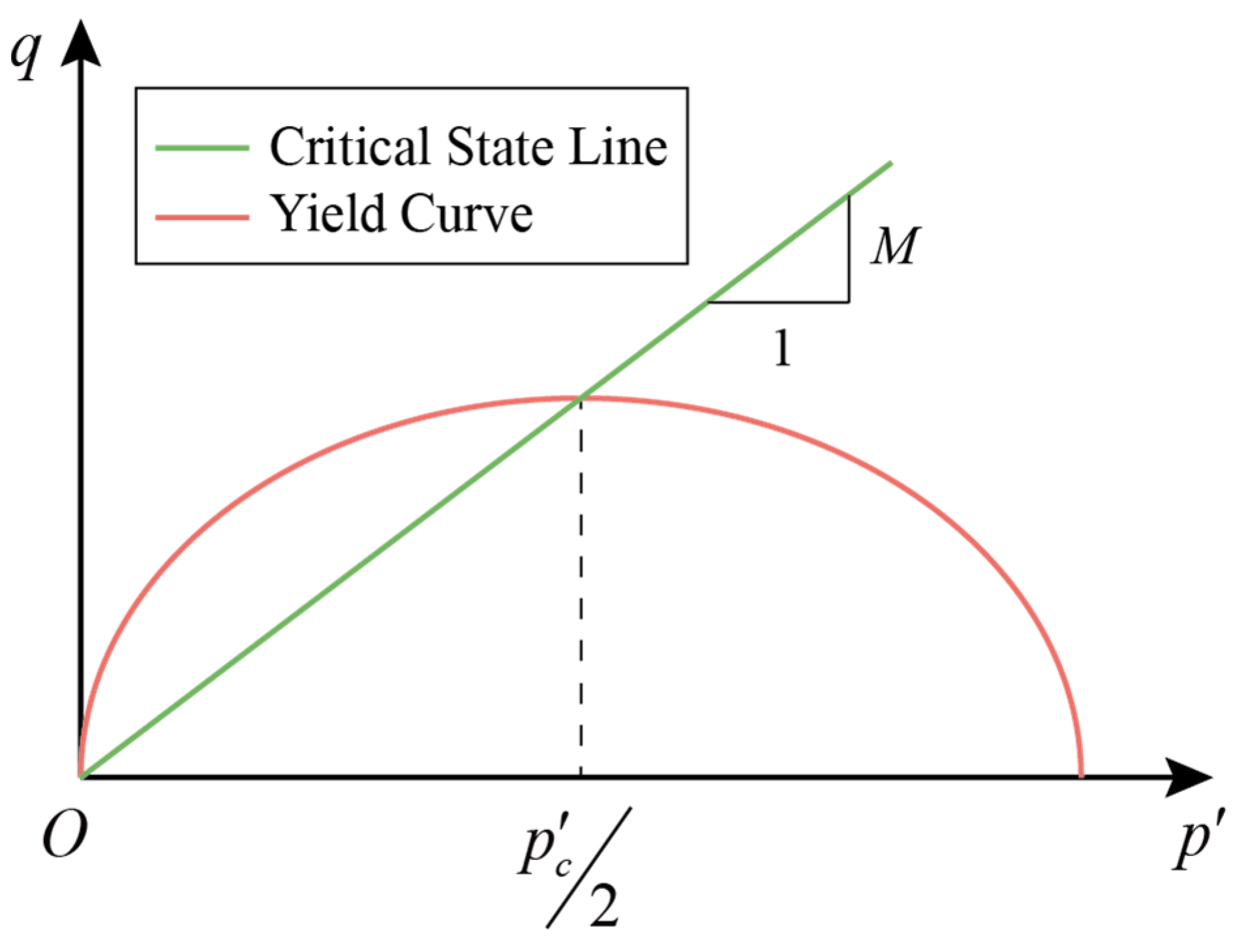



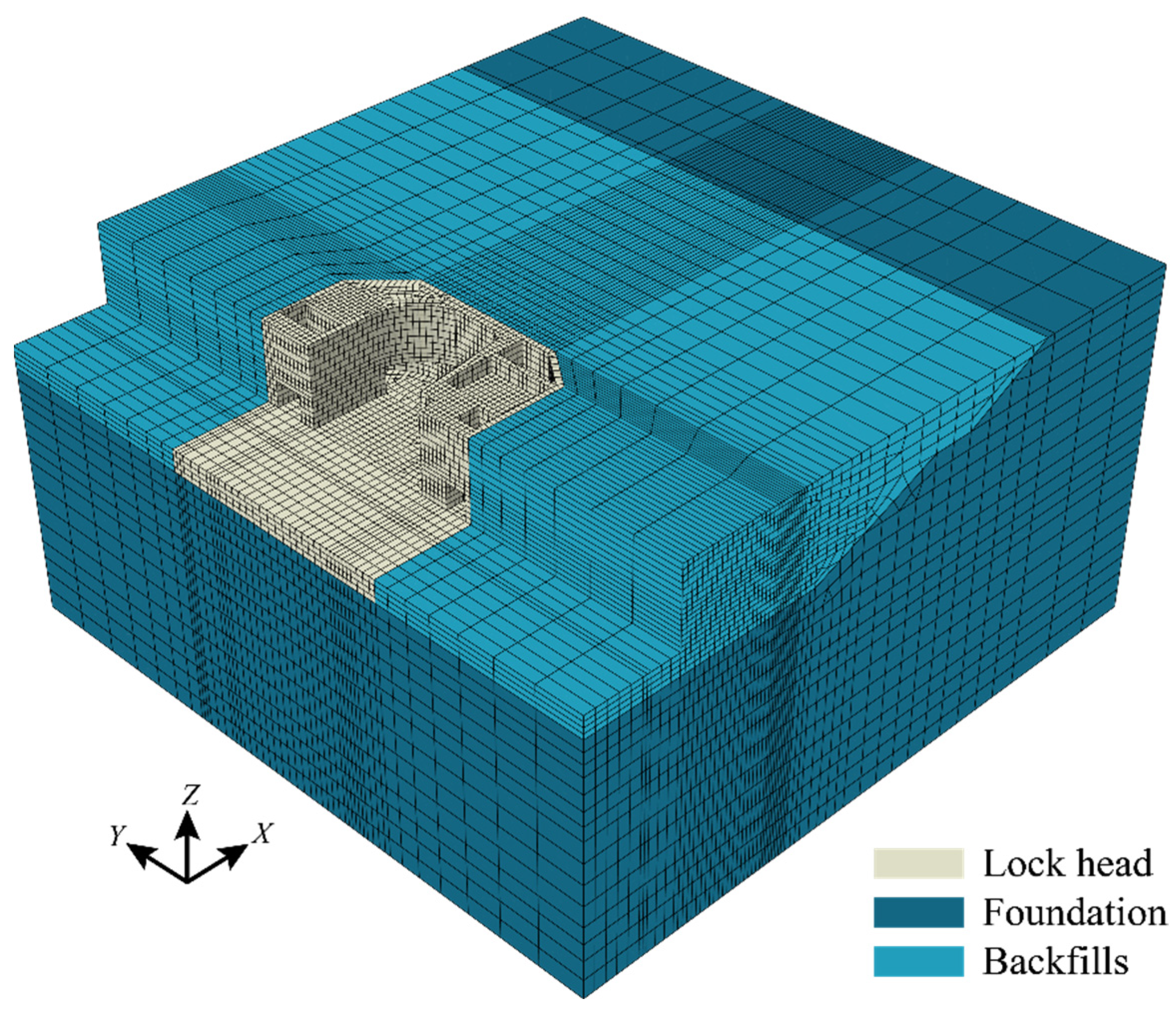


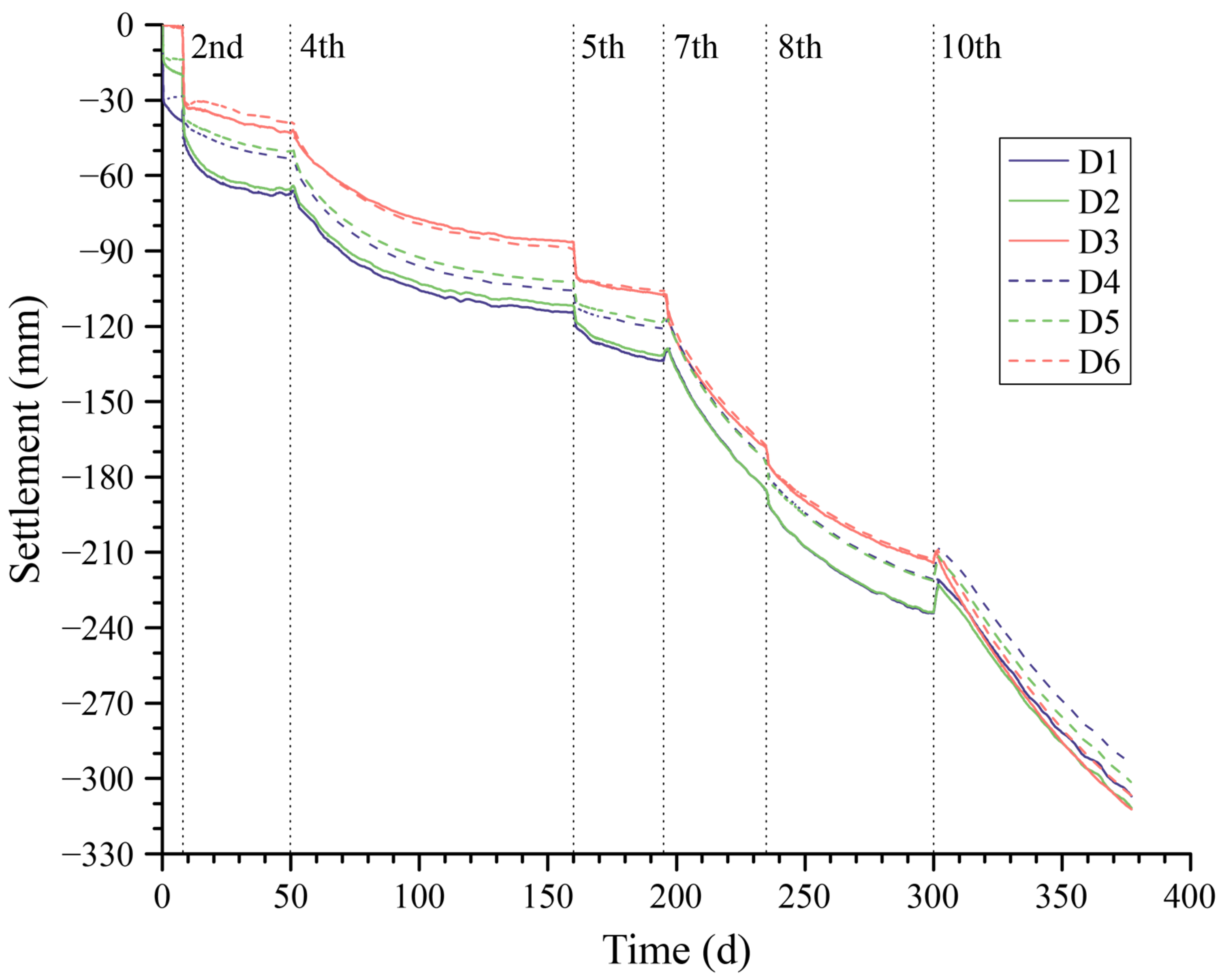
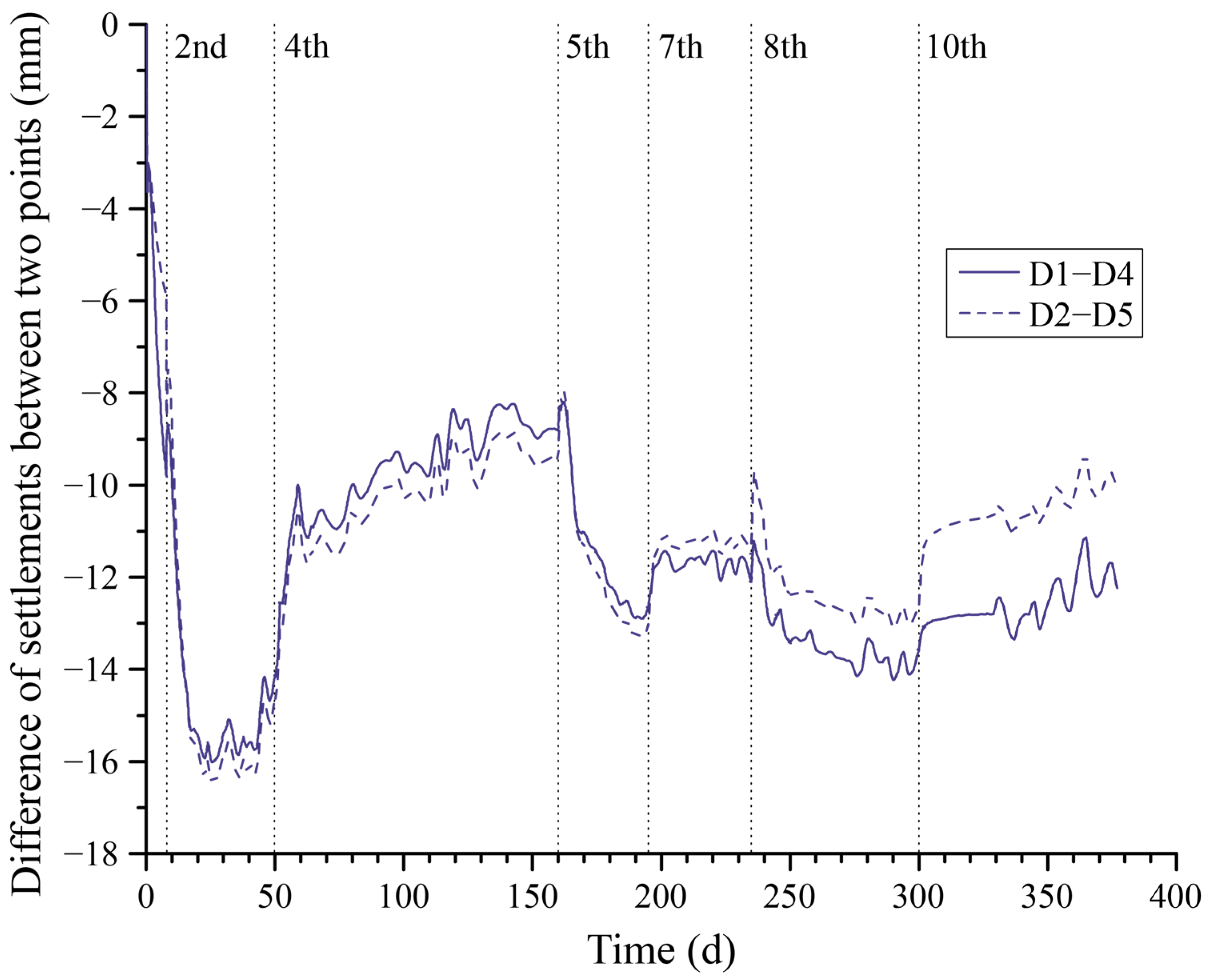
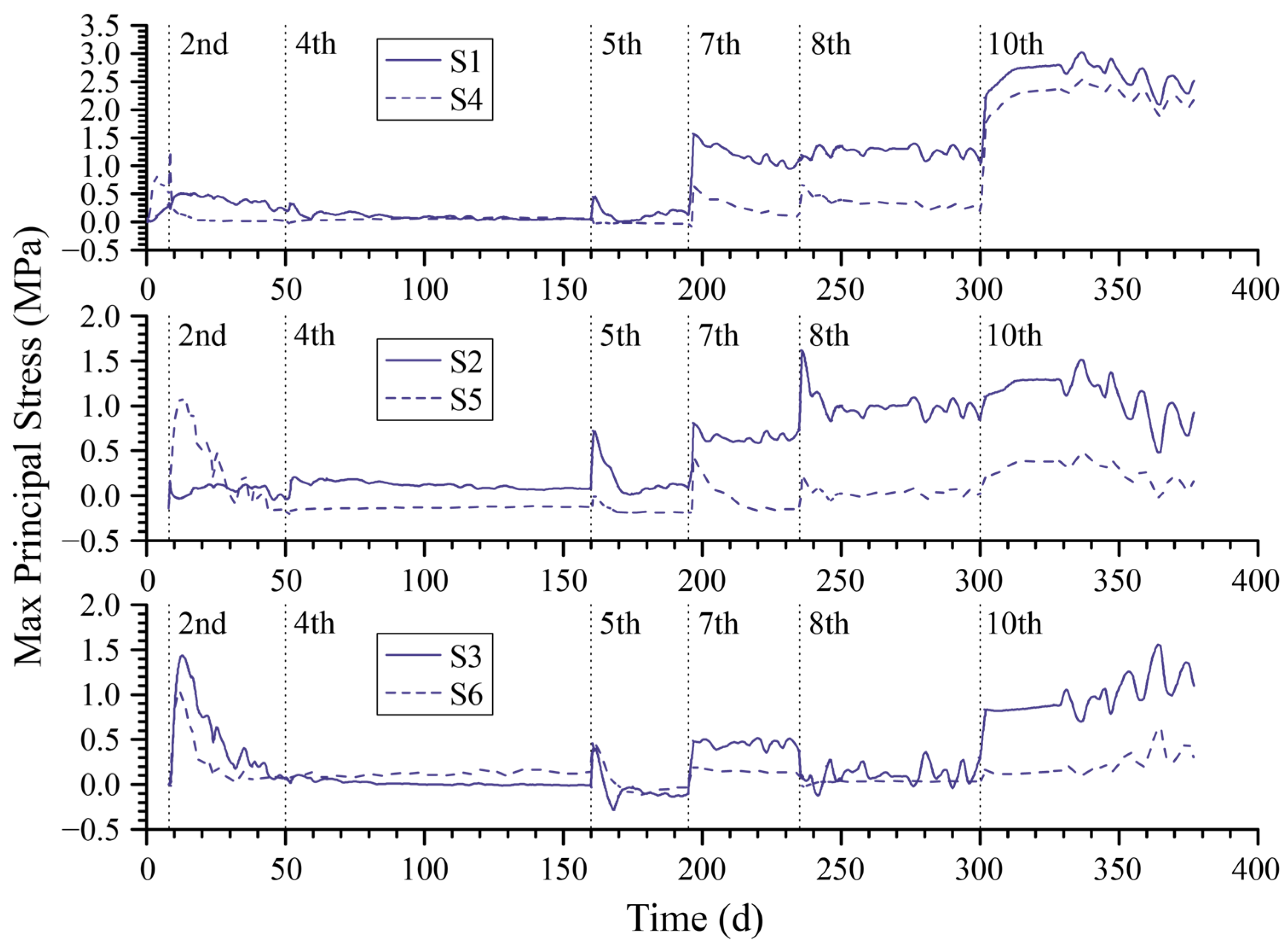
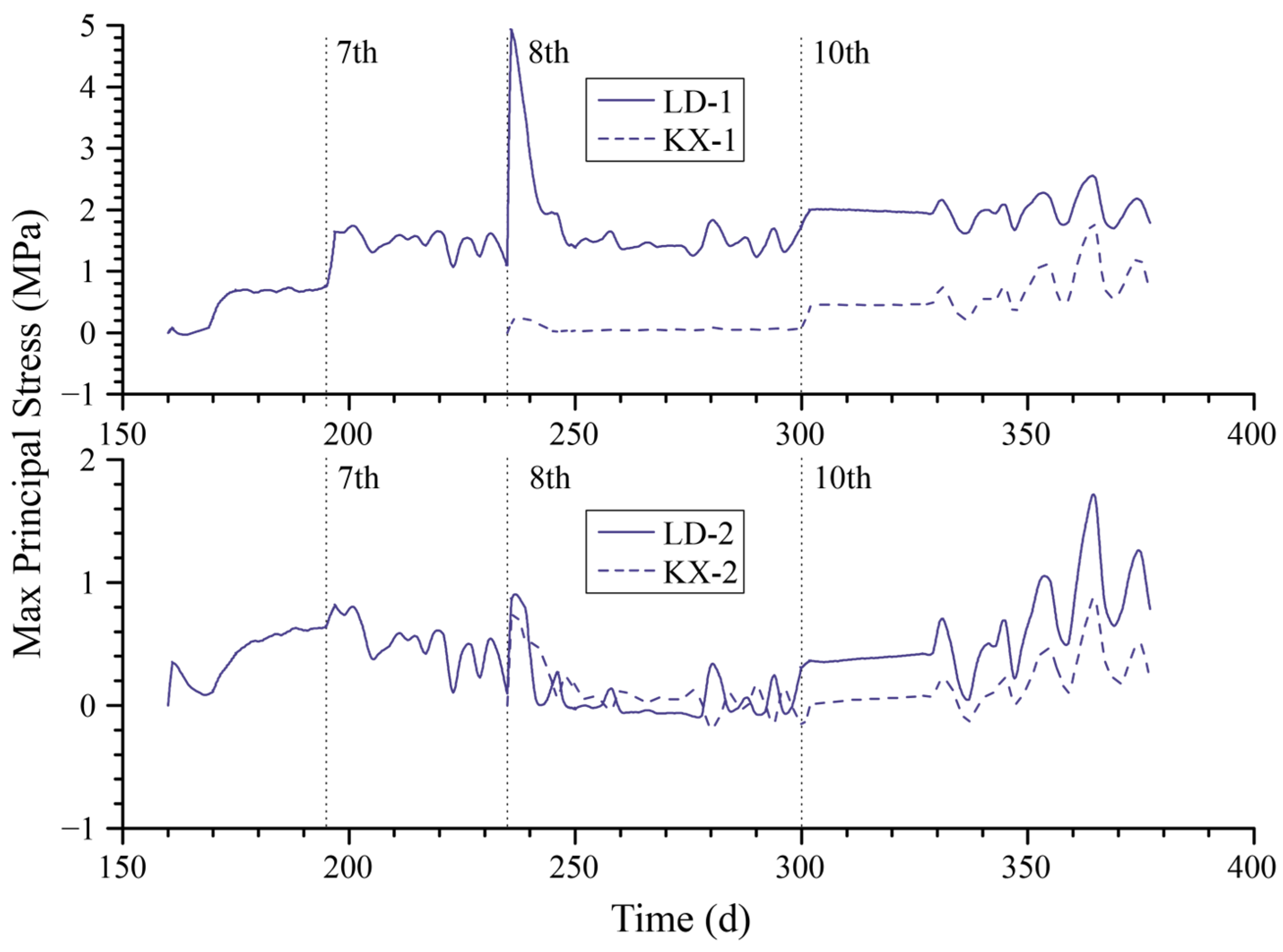

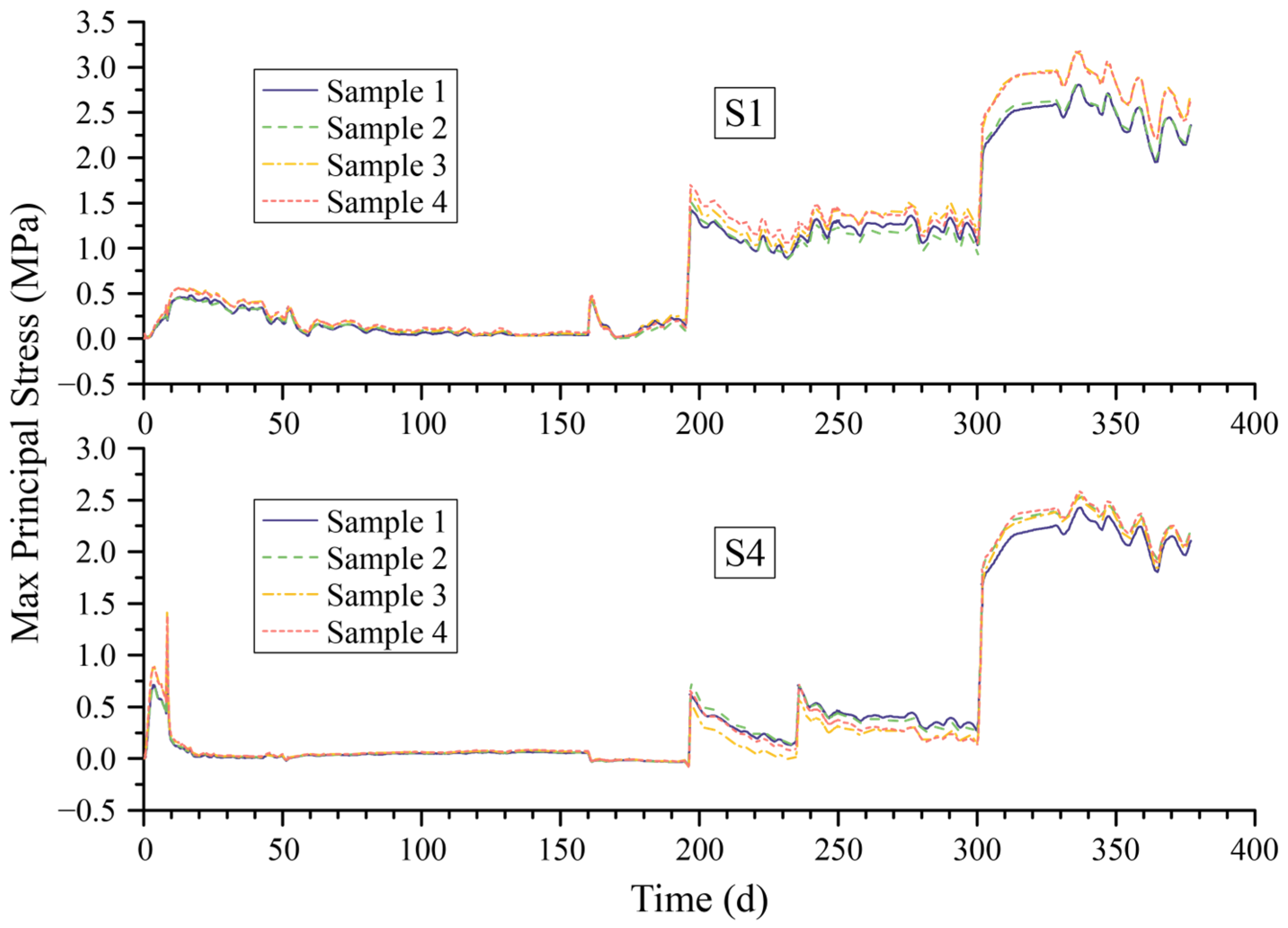
| No. | Step Name | Duration (Days) |
|---|---|---|
| 1st | Casting central floors | 8 |
| 2nd | Casting side floors | 8 |
| 3rd | Dismantling formworks of the floor | 34 |
| 4th | Backfilling the first soil layer | 110 |
| 5th | Casting water corridor section | 10 |
| 6th | Dismantling formworks of water corridor section | 25 |
| 7th | Backfilling the second soil layer | 40 |
| 8th | Casting hollow box section | 10 |
| 9th | Dismantling formworks of hollow box section | 55 |
| 10th | Backfilling the third soil layer | 77 |
| Material | k kJ/(m∙d∙°C) | c kJ/(kg∙°C) | kJ/(m2∙d∙°C) |
|---|---|---|---|
| Concrete | 200.145 | 0.984 | 413 with formworks 1360 without formworks |
| Subsoil and backfilled soil | 100.63 | 1.005 | 500 |
| No. | M | ||
|---|---|---|---|
| 1 | 0.0836 | 0.00706 | 1.351 |
| 2 | 0.0820 | 0.00697 | 1.052 |
| 3 | 0.0341 | 0.00454 | 1.063 |
| 4 | 0.1661 | 0.01126 | 0.993 |
| 5 | 0.1381 | 0.00983 | 0.852 |
| 6 | 0.0671 | 0.00622 | 1.102 |
| 7 | 0.0919 | 0.00748 | 1.067 |
| 8 | 0.1117 | 0.00848 | 0.864 |
| 9 | 0.0853 | 0.00714 | 0.933 |
| No. | OCR | kPa | m/d | kg/m3 | ||
|---|---|---|---|---|---|---|
| 1 | 1.312 | 217.667 | 7.0 | 65.925 | 0.5 | 1880 |
| 2 | 0.962 | 191.361 | 4.0 | 47.436 | 0.003 | 1900 |
| 3 | 0.594 | 158.689 | 2.0 | 40.815 | 0.086 | 1870 |
| 4 | 0.664 | 183.466 | 1.5 | 45.918 | 0.776 | 1900 |
| 5 | 0.587 | 247.882 | 1.3 | 53.009 | 0.003 | 2010 |
| 6 | 0.452 | 243.234 | 1.1 | 67.786 | 0.003 | 1880 |
| 7 | 0.459 | 287.498 | 1.0 | 77.975 | 0.776 | 1900 |
| 8 | 0.483 | 409.240 | 1.0 | 89.043 | 0.003 | 1980 |
| 9 | 0.450 | 450.587 | 1.0 | 105.768 | 0.003 | 1890 |
| No. | E and C | λ and κ | |
|---|---|---|---|
| Sample 1 | 0.9 | 0.9 | 0.9 |
| Sample 2 | 0.9 | 1.1 | 1.1 |
| Sample 3 | 1.1 | 0.9 | 1.1 |
| Sample 4 | 1.1 | 1.1 | 0.9 |
| No. | D1 (mm) | D4 (mm) | S1 (MPa) | S4 (MPa) |
|---|---|---|---|---|
| Sample 1 | 274.456 | 262.878 | 2.80315 | 2.42602 |
| Sample 2 | 338.13 | 325.097 | 2.82619 | 2.54617 |
| Sample 3 | 289.682 | 278.144 | 3.19282 | 2.55406 |
| Sample 4 | 321.78 | 309.159 | 3.17707 | 2.58789 |
| Parameter | S-D1 | S-D4 | -S1 | -S4 |
|---|---|---|---|---|
| E | 0.2400 | 0.2471 | 0.2770 | 0.2121 |
| C | 0.1727 | 0.1913 | 0.2413 | 0.2594 |
| λ | 0.2111 | 0.1984 | 0.1537 | 0.1669 |
| κ | 0.2003 | 0.1950 | 0.1707 | 0.1956 |
| 0.1759 | 0.1628 | 0.1574 | 0.1661 |
| Parameter | S-D1 | S-D4 | -S1 | -S4 |
|---|---|---|---|---|
| E | −0.4030 | −0.4312 | 1.0586 | 0.7369 |
| C | −0.0432 | −0.0495 | −0.9146 | −0.9591 |
| λ | 1.2797 | 1.2568 | −0.1500 | 0.7506 |
| κ | 1.1243 | 1.1175 | 0.0664 | 0.8368 |
| 0.9164 | 0.9036 | 0.0133 | 0.4991 |
Disclaimer/Publisher’s Note: The statements, opinions and data contained in all publications are solely those of the individual author(s) and contributor(s) and not of MDPI and/or the editor(s). MDPI and/or the editor(s) disclaim responsibility for any injury to people or property resulting from any ideas, methods, instructions or products referred to in the content. |
© 2024 by the authors. Licensee MDPI, Basel, Switzerland. This article is an open access article distributed under the terms and conditions of the Creative Commons Attribution (CC BY) license (https://creativecommons.org/licenses/by/4.0/).
Share and Cite
Xu, C.; Ye, L.; Pan, S.; Luo, W. Integrated Time-Dependent Analysis of a Hydraulic Structure on Soft Foundations during Construction. Water 2024, 16, 1375. https://doi.org/10.3390/w16101375
Xu C, Ye L, Pan S, Luo W. Integrated Time-Dependent Analysis of a Hydraulic Structure on Soft Foundations during Construction. Water. 2024; 16(10):1375. https://doi.org/10.3390/w16101375
Chicago/Turabian StyleXu, Chao, Liang Ye, Suli Pan, and Wen Luo. 2024. "Integrated Time-Dependent Analysis of a Hydraulic Structure on Soft Foundations during Construction" Water 16, no. 10: 1375. https://doi.org/10.3390/w16101375
APA StyleXu, C., Ye, L., Pan, S., & Luo, W. (2024). Integrated Time-Dependent Analysis of a Hydraulic Structure on Soft Foundations during Construction. Water, 16(10), 1375. https://doi.org/10.3390/w16101375






